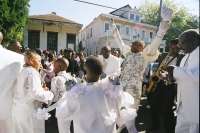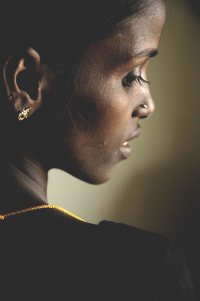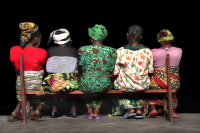Faubourg Tremé: The Untold Story of Black New Orleans is riveting tale of hope, heartbreak and resilience set in New Orleans’ most fascinating neighborhood. Shot largely before Hurricane Katrina and edited afterwards, the film is both celebratory and elegiac in tone. Faubourg Tremé is arguably the oldest black neighborhood in America, the birthplace of the Civil Rights movement in the South and the home of jazz. While the Tremé district was damaged when the levees broke, this is not another Katrina documentary. Every frame is a tribute to what African American communities have contributed even under the most hostile of conditions. It is a film of such effortless intimacy, subtle glances and authentic details that only two native New Orleanians could have made it. Our guide through the neighborhood is New Orleans’ Times Picayune columnist Lolis Eric Elie who bought a historic house in Tremé in the 1990’s when the area was struggling to recover from the crack epidemic. Rather than flee the blighted inner city, Elie begins renovating his dilapidated home and in the process becomes obsessed with the area’s mysterious and neglected past. The film follows the progress of his renovation, which eventually emerges as a poignant metaphor for post-Katrina reconstruction of New Orleans. Irving Trevigne, Elie’s seventy-five year old Creole carpenter, is the heart and soul of the neighborhood and a born storyteller. Descended from over two hundred years of skilled craftsmen, he beguiles Elie with the forgotten stories behind Tremé’s old buildings. Other neighborhood chroniclers like Louisiana Poet Laureate Brenda Marie Osbey, musician Glen David Andrews and renowned historians John Hope Franklin and Eric Foner help bring alive a compelling and complex historical experience that gracefully combines pre and post hurricane footage with a wealth of never-before-seen archival imagery. Long ago during slavery, Faubourg Tremé was home to the largest community of free black people in the Deep South and a hotbed of political ferment. Here black and white, free and enslaved, rich and poor cohabitated, collaborated, and clashed to create much of what defines New Orleans culture up to the present day. Founded as a suburb (or faubourg in French) of the original colonial city, the neighborhood developed during French rule and many families like the Trevignes kept speaking French as their first language until the late 1960’s. The film brims with unknown historical nuggets: Who knew that in the early 1800’s, while most African Americans were toiling on plantations, free black people in Tremé were publishing poetry and conducting symphonies? Who knew that long before Rosa Parks, Tremé leaders organized sit-ins and protests that successfully desegregated the city’s streetcars and schools? Who knew that jazz, the area’s greatest gift to America, was born from the embers of this first American Civil Right’s movement. This film is imaginative, revealing, and disturbing. The images are unforgettable, reminding us of who we are and who we have been. Today many Tremé residents are unable to return home and the neighborhood is once again fighting many of the same civil rights battles first launched here a hundred and fifty years ago. Faubourg Tremé: The Untold Story of Black New Orleans celebrates the resiliency of this community and how they managed to carve out a unique and expressive culture and history that would enrich America and the world.”
Summary info for schedule – will be hidden on film page

Faubourg Treme: The Untold Story of Black New Orleans
79-minutes
Screening day / time
Faubourg Treme: The Untold Story of Black New Orleans
Faubourg Treme: The Untold Story of Black New Orleans
Filmmaker Notes:
We are New Orleans filmmakers, one black and one white. With the failure of the federal levees after Hurricane Katrina, our entire city was transformed overnight into the symbol of all that has gone wrong in America, in particular its deepening racial and economic divide. Seared into the nation’s consciousness are images of desperately poor black people trapped on rooftops and denied the most basic protection of American citizenship. Those images have come to represent black New Orleans.Our goal in making this film was to tell the story behind those images. We chose to focus on one NewOrleans neighborhood, Faubourg Tremé, a historic community that like much of the old city is predominantly African American, poor, and steeped in distinctly un-American traditions. For usFaubourg Tremé is quintessential New Orleans. We wanted to capture the spirit of this place that haspersevered in the face of great hostility for centuries and created a culture and history that enrichedAmerica and the world.These days, “character driven” documentaries are all the rage. In editing this film, however, we chose not to structure our story around the personal dramas of our wonderful individual characters but to highlight the larger drama of community. We hope New Orleans itself becomes the character you laugh and cry with, and come to love.Our film focuses on a forgotten 19th century Civil Rights Movement in New Orleans and the music and writing that was born of those dreams. We ourselves are both products of a later Civil RightsMovement. Our parents were Civil Rights activists. We were each sent to integrate New Orleans schools — Lolis to an elite all-white private school, Dawn to an inner city public school that had beenabandoned by white parents after desegregation. Our childhood memories are of picket lines, voterregistration drives and dreams of a new New Orleans.Today, there’s another new New Orleans in the planning and a new generation of young Americanstrekking South to help in the rebuilding. Many of the battles of the past are being fought again. In the course of making this film, the Tremé neighborhood was transformed from one of the most rooted communities in America to among the most uprooted. Before the hurricane, one of the things old people loved to tell us over and over was “You can’t possibly know where you’re going if you don’t know where you’ve been.” Back then, this expression sounded to us like a simplistic cliché. After the flood, it became our mantra too. The history of New Orleans is littered with tragic paths not taken. But it’s also rich with tales of brave uprisings, interracial collaboration, endurance and creativity. Our hope is that this film can help heal, educate and inspire at this critical moment in New Orleans’ future.”~Dawn Logsdon and Lolis Eric Elie



